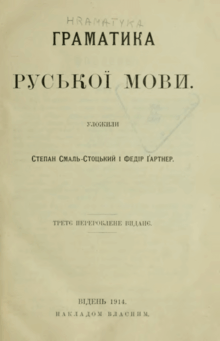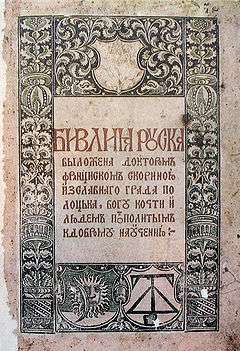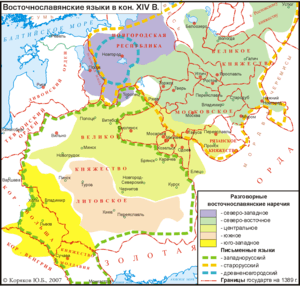Ruthenian language
| Ruthenian | |
|---|---|
| Old Ruthenian | |
|
руска(я) мова[1][2] ruska(ja) mova | |
| Native to | Polish–Lithuanian Commonwealth (influenced Church Slavonic - language of administration of Grand Duchy of Lithuania until 1699) |
| Extinct | developed into Belarusian, Ukrainian and Rusyn. |
| Language codes | |
| ISO 639-3 | – |
orv-olr | |
| Glottolog | None |
Ruthenian or Old Ruthenian (рүскій єзыкь, see other names) was the group of varieties of East Slavic spoken in the Grand Duchy of Lithuania and later in the East Slavic territories of the Polish–Lithuanian Commonwealth. The written form is also called Chancery Slavonic by Lithuanian and Western European linguists.[3]
Scholars do not agree whether Ruthenian was a separate language, or a Western dialect or set of dialects of Old East Slavic, but it is agreed that Ruthenian has a close genetic relationship with it. Old East Slavic was the colloquial language used in Kievan Rus' (10th–13th centuries).[4] Ruthenian is seen as a predecessor of modern Belarusian, Rusyn and Ukrainian. Indeed, all these languages, from Old East Slavic to Rusyn, have been labelled as Ruthenian (Ukrainian: Рутенська мова, русинська мова) at some point in history.
Nomenclature



In modern texts, the language in question is sometimes called "Old Ukrainian" or "Old Belarusian" (Ukrainian: “Староукраїнська мова”) and (Belarusian: “Старабеларуская мова”). As Ruthenian was always in a kind of diglossic opposition to Church Slavonic, this vernacular language was and still is often called prosta(ja) mova (Cyrillic проста(я) мова), literally "simple speech".
- Names in contemporary use
- Ruthenian (Old Belarusian: руски езыкъ) — by the contemporaries, but, generally, not in contemporary Russia.
- (variant) Simple Ruthenian or simple talk (Old Belarusian: простый руский (язык) or простая молва, про́ста мова) — publisher Grigoriy Khodkevich (16th century).
- Lithuanian (Russian: Литовский язык) — possibly, exclusive reference to it in the contemporary Russia. Also by Zizaniy (end of the 16th century), Pamva Berynda (1653).
- Names in modern use
- (Old) Ruthenian — modern collective name, covering both Old Belarusian and Old Ukrainian languages, predominantly used by the 20th-century Lithuanian, also many Polish and English researchers.
- (Old) West Russian, language or dialect (Russian: (Древний) западнорусский язык, Russian: (Древнее) западнорусское наречие) — chiefly by the supporters of the concept of the Proto-Russian phase, esp. since the end of the 19th century, e.g., by Karskiy, Shakhmatov. Russian Wikipedia uses the term West Russian written language (Западнорусский письменный язык).
- (Old) Belarusian (language) — rarely in contemporary Russia. Also Kryzhanich. The denotation Belarusian (language) (Russian: белорусский (язык)) when referring both to the 19th-century language and to the Medieval language had been used in works of the 19th-century Russian researchers Fyodor Buslayev, Ogonovskiy, Zhitetskiy, Sobolevskiy, Nedeshev, Vladimirov and Belarusian nationalists, such as Karskiy.
- Lithuanian-Russian (Russian: литовско-русский) — by 19th-century Russian researchers Keppen, archbishop Filaret, Sakharov, Karatayev.
- Lithuanian-Slavonic (Russian: литово-славянский) — by 19th-century Russian researcher Baranovskiy.[5]
- Old Ukrainian or staroukrajinska mova (Ukrainian: “Староукраїнська мова”).
- Chancery Slavonic - for the written form of Old Church Slavonic, influenced by various Ruthenian dialects and was used in the chancery of Grand Duchy of Lithuania.[6]
- ruski — used by Norman Davies in Vanished Kingdoms: The History of Half-Forgotten Europe.
Divergence between literary Ruthenian and literary Russian

As Eastern Europe gradually freed itself from the "Tatar yoke" in the 14th century, 2 separate mainly East Slavic states emerged: the Grand Duchy of Moscow (Muscovy), which eventually evolved into the Tsardom of Russia and subsequently the Russian Empire; the Kingdom of Galicia-Volhynia. Many of Ruthenic lands conquered by the Lithuanians were incorporated into the Grand Duchy of Lithuania, which covered roughly the territories of modern Belarus, Ukraine, Lithuania, and western Russia, and later united with Poland to form the Polish–Lithuanian Commonwealth. Linguistically, both states continued to use the regional varieties of the literary language of Kievan Rus', but due to the immense Polish influence in the west and to the Church Slavonic influence in the east, they gradually developed into two distinct literary languages: Ruthenian in Lithuania and the Commonwealth, and (Old) Russian in Muscovy. Both were usually called Ruskij (of Rus’) or Slovenskij (Slavonic); only when a differentiation between the literary language of Muscovy and the one of Lithuania was needed was the former called Moskovskij 'Muscovite' (and, rarely, the latter Lytvynskij 'Lithuanian').
This linguistic difference is confirmed by the need for translators during the mid-17th-century negotiations for the Treaty of Pereyaslav, between Bohdan Khmelnytsky, ruler of the Zaporozhian Host, and the Tsardom of Russia.
References
- ↑ Ж. Некрашевич-Короткая. Лингвонимы восточнославянского культурного региона (историчесикий обзор) // Исследование славянских языков и литератур в высшей школе: достижения и перспективы: Информационные материалы и тезисы докладов международной научной конференции / Под ред. В. П. Гудкова, А. Г. Машковой, С. С. Скорвида. — М., 2003. — С. 150 — 317 с.
- ↑ Начальный этап формирования русского национального языка, Ленинград 1962, p. 221
- ↑ e.g., Elana Goldberg Shohamy and Monica Barni, Linguistic Landscape in the City (Multilingual Matters, 2010: ISBN 1847692974), p. 139: "[The Grand Duchy of Lithuania] adopted as its official language the literary version of Ruthenian, written in Cyrillic and also known as Chancery Slavonic"; Virgil Krapauskas, Nationalism and Historiography: The Case of Nineteenth-Century Lithuanian Historicism (East European Monographs, 2000: ISBN 0880334576), p. 26: "By the fifteenth and sixteenth centuries Chancery Slavonic dominated the written state language in the Grand Duchy of Lithuania"; Timothy Snyder, The Reconstruction Of Nations: Poland, Ukraine, Lithuania, Belarus, 1569-1999 (Yale University Press, 2004: ISBN 030010586X), p. 18: "Local recensions of Church Slavonic, introduced by Orthodox churchmen from more southerly lands, provided the basis for Chancery Slavonic, the court language of the Grand Duchy."
- ↑ Ukrainian language, Encyclopædia Britannica
- ↑ Cited in Улащик Н. Введение в белорусско-литовское летописание. — М., 1980.
- ↑ Zinkevičius, Zigmas. "LIETUVOS DIDŽIOSIOS KUNIGAIKŠTYSTĖS KANCELIARINĖS SLAVŲ KALBOS TERMINO NUSAKYMO PROBLEMA". viduramziu.istorija.net (in Lithuanian). Retrieved 2 August 2018.
Literature
- Brogi Bercoff, Giovanna: “Plurilingualism in Eastern Slavic culture of the 17th century: The case of Simeon Polockij.” In: Slavia: Časopis pro slovanskou filologii, vol. 64. p. 3-14.
- Danylenko, Andrii: "'Prostaja mova', 'Kitab', and Polissian Standard". In: Die Welt der Slaven LI (2006), no. 1, p. 80-115.
- Danylenko, Andrii: "On the Name(s) of the prostaja mova in the Polish-Lithuanian Commonwealth", In: Studia Slavica Hung., 51/1-2 (2006),p. 97-121
- Dingley, Jim [James]. “The two versions of the Gramatyka Slovenskaja of Ivan Uževič.’ In: The Journal of Byelorussian Studies, 2.4 (year VIII), p. 369-384.
- Frick, David A. "'Foolish Rus': On Polish civilization, Ruthenian self-hatred, and Kasijan Sakovyč." In: Harvard Ukrainian studies 18.3/4 (1994), p. 210-248.
- Martel, Antoine. La langue polonaise dans les pays ruthènes: Ukraine et Russie Blanche 1569/1667. Lille 1938.
- Moser, Michael: "Mittelruthenisch (Mittelweißrussisch und Mittelukrainisch): Ein Überblick." In: Studia Slavica Academiae Scientiarum Hungaricae 50 (2005), no. 1-2, p. 125-142.
- Mozer [= Moser], Michaėl’. "Čto takoe 'prostaja mova'?". In: Studia Slavica Academiae Scientiarum Hungaricae 47.3/4 (2002), p. 221-260.
- Pivtorak, Hryhorij. “Do pytannja pro ukrajins’ko-bilorus’ku vzajemodiju donacional’noho periodu (dosjahnennja, zavdannja i perspektyvy doslidžen’)”. In: Movoznavstvo 1978.3 (69), p. 31-40.
- Pugh, Stefan M.: Testament to Ruthenian. A Linguistic Analysis of the Smotryc’kyj Variant. Cambridge 1996 (= Harvard Series of Ukrainian Studies).
- Shevelov, George Y. “Belorussian versus Ukrainian: Delimitation of texts before A.D. 1569”. In: The Journal of Byelorussian Studies 3.2 (year 10), p. 145-156.
- Stang, Christian: Die westrussische Kanzleisprache des Grossfürstentums Litauen. Oslo 1935 (= Skrifter utgitt av Det Norske Videnskaps-Akademi i Oslo, Historisk-filosofisk Klasse 1935,2).
- Strumins’kyj, Bohdan. “The language question in the Ukrainian lands before the nineteenth century”. In: Aspects of the Slavic language question. Ed. Riccardo Picchio, Harvey Goldblatt. New Haven 1984, vol. 2, p. 9-47.
External links
| Ruthenian language test of Wikipedia at Wikimedia Incubator |
| Wikimedia Commons has media related to Ruthenian language. |